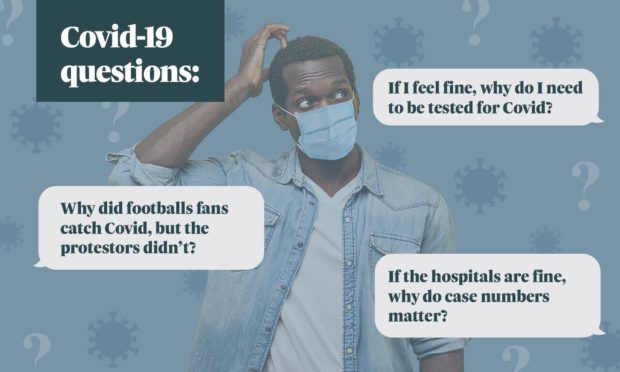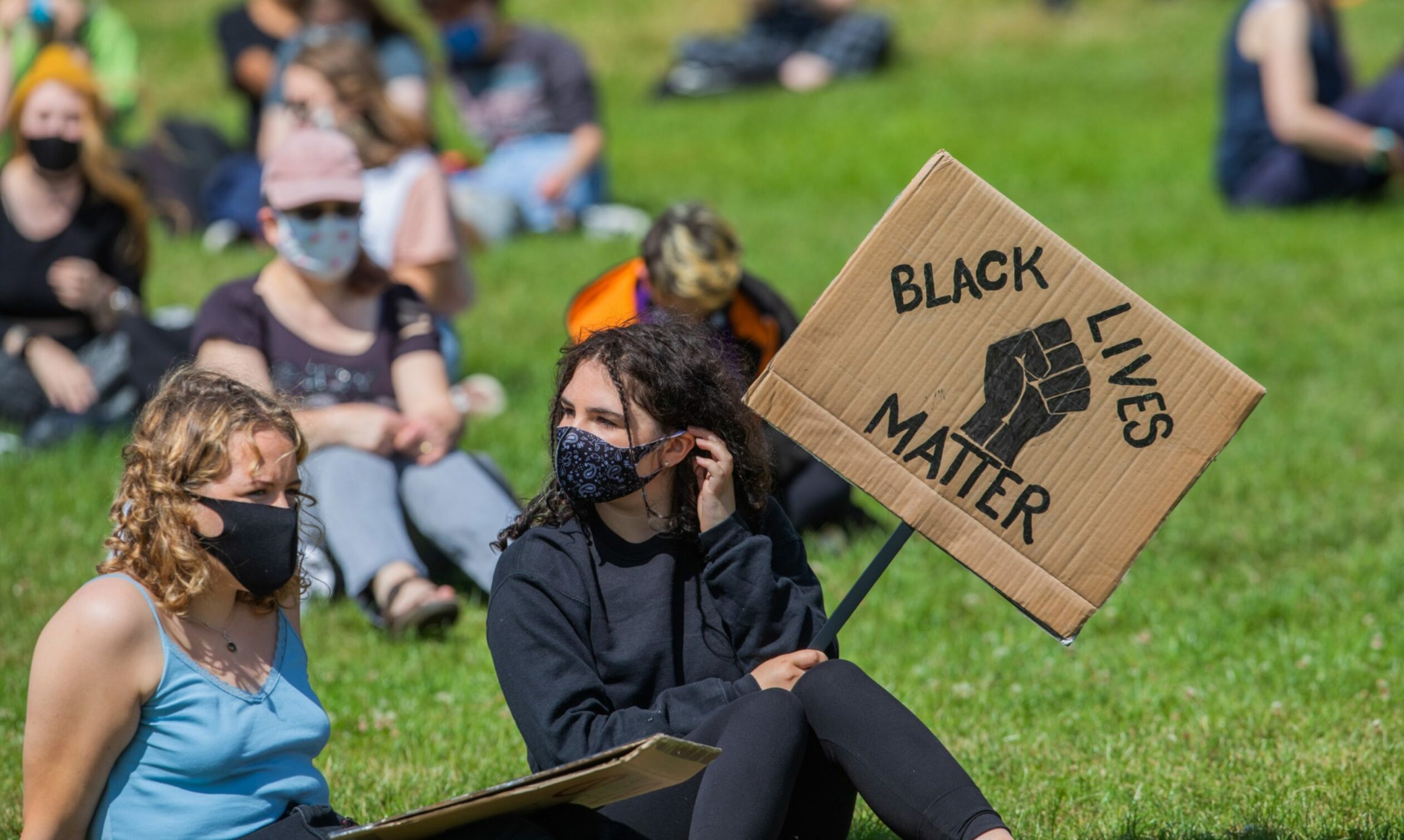As we near the 18-month mark since the pandemic hit the country, many questions still remain regarding Covid, testing and the handling of the health crisis by governments across the world.
We’ve taken a look at some of the most common concerns raised by friends, family members and users of social media – and gone to the experts to find answers.
Q: “If I feel fine, why do I need to get tested for Covid?”
Questions have been raised as to why asymptomatic testing is becoming widespread, with accusations they only serve to “pad” numbers and make the health crisis appear worse than it is.
But Chris Littlejohn, the deputy director of public health at NHS Grampian, has likened the situation to an iceberg.
Covid-positive people appear above the water – with health bosses unaware of how many asymptomatic people there are beneath the surface.
“The only way for us to know is to ask people to get tested,” he said.
“This helps us see the transmission links and the edges of an outbreak – otherwise we’re operating in the dark.
“The more you test, potentially the more cases we’ll find, and we’re finding more people without symptoms or relatively minor initial symptoms.
“You need to see where your seriously ill people are, but also where those not showing symptoms are, as it shows you the edges of it.
“It helps us target messages, vaccine clinics and extra testing capacity.”
Q: “Don’t we only have rising numbers because we’re testing more?”
Throughout the pandemic, testing has steadily increased in line with lab capacity and the availability of lateral flow devices.
As a result, the more tests carried out, the higher the likelihood of more positive cases being found.
But case numbers on their own show very little – these are often combined with information regarding test positivity, hospitalisations and deaths, to give a fuller context.
The World Health Organisation says test positivity rates should remain below 5% wherever possible, and anything above that suggests the virus is spreading out of control.
These figures are useful when determining how widespread community transmission may be.
In recent weeks these have risen above 10% in many parts of Scotland – but are still below the near 40% experienced at the start of the pandemic.
So, while an increase in testing is at least partly responsible for rising case numbers, there are many other figures at play which are giving health chiefs cause for concern.
Q: “If the hospitals are fine, why do case numbers matter?”
At the beginning of the pandemic, the key message for the public was “Stay home, protect the NHS, save lives”.
With the roll-out of the vaccine now widespread, around 5% of all Covid cases are expected to result in hospitalisation, down from approximately 10% in January.
But First Minister Nicola Sturgeon said: “5% of a large number of cases will still put huge pressure on NHS and cause suffering and loss.”
And Jillian Evans, head of health intelligence at NHS Grampian, said it “could lead to serious disruption of health services, particularly in primary care and A&E, even if they don’t translate into people being seriously unwell enough to be admitted.”
However, a small number of people requiring treatment in Covid wards is not the only sign of pressure on the health service.
Questions still remain as to how many people may have mild symptoms initially, but contract long Covid and require additional care potentially far into the future.
And as restrictions have eased, people are more free to meet up with one another – meaning the typical Covid case is now associated with more close contacts than before.
This has led to increasing numbers of NHS staff self-isolating, with some operations already postponed in Grampian and visiting rules tightened up.
In the north-east last autumn, the average person had 1.5 close contacts. This has now increased to 6.4, with a “not insignificant” number of people reporting having socialised with 30 to 40 others.
The Scottish Government has said the contact tracing system is currently “under pressure” – but is not yet struggling to cope with demand.
Q: “Why didn’t the protestors get Covid last year, but football fans did?”
Staff at the National Bureau of Economic Research in Massachusetts, USA, published an 85-page paper on this topic in January.
Using data collected on the BLM protests and anonymised phone data, they found “strong evidence” more people than usual stayed at home during the demonstrations.
Their research paper said: “Non-protesters shifted their activity in response to the perceived heightened risk of contagion and protest-related violence.
“Moreover, we find that the types of activities that were averted by BLM protests were potentially riskier for disease spread than outdoor civil rights protests: restaurant and bar-going and retail shopping.
“These risk-avoiding responses to protests, coupled with mask-wearing by protesters, explain why BLM protests did not reignite community-level Covid-19 growth.”
And in March 2021 the UK government’s chief scientific advisor, Sir Patrick Vallance, told the Science and Technology Committee: “It is difficult to see how things like large beach gatherings and so on can cause a spike.
“The same was the case in a protest march in New York; they did not really see any spikes after that.”
In comparison, many football fans have been spending longer periods of time together with larger numbers of others and in closer company, including inside pubs, bars and public transport.
In June, it was revealed almost 2,000 Covid cases were directly linked to Scotland’s Euro 2020 campaign – approximately 6% of all positive test results during the period.
Q: “Why is Covid the only crisis with an advertising campaign?”
Public health ad campaigns are nothing new – we often see print and TV adverts for the likes of flu jabs, healthy eating and exercise.
During the 1964 typhoid outbreak in Aberdeen, Green Final mascot Wee Alickie was used to promote good hygiene to cut down on infection rates.
During 1964 outbreak of #typhoid in #Aberdeen this leaflet with Wee Alickie showed how to prevent its spread #histmed pic.twitter.com/g3UvHoH8sM
— NHS Grampian Archives (@NHSGArchives) July 30, 2015
Across the 2019-20 financial year, the Scottish Government spent just under £1.5 million on advertising health campaigns.
Documents show this included £550,000 for detecting cancer early, £445,000 regarding organ donation and a £315,000 spent on recommended guidelines for alcohol.
Amid a health crisis, resources are often diverted to where they are needed most – in this case, towards coronavirus messaging.
But other campaigns are still taking place. In the last month alone, NHS 24 has promoted yoga, good mental health and supported the national Dementia Awareness Week.
Q: “Why do we reset the death counts for other illnesses annually, but Covid remains cumulative?”
Due to the way data scientists across the world have worked together during the pandemic, we are able to access incredibly accurate statistics on how many Covid cases and deaths there have been, as well as how many vaccines have been given.
Knowing the first case was discovered in December 2019, it means we know exactly how many cases have been reported by each government, and when each was.
Similar stats have been published for the likes of the 2003 Sars epidemic, 2004 Ebola outbreak and Middle Eastern Respiratory Syndrome (Mers), which emerged in 2012.
Other illnesses, however, have affected us for decades, if not centuries, longer – in the days before modern, up-to-the minute reporting.
This means it would be impossible to say exactly how many people have died from the likes of cancer or heart disease.
In cases such as these, annual figures are used instead – also providing an insight into how the numbers are changing year-on-year.
It is predicted that we may need to “live with” Covid in the same way we do flu. If this happens, it is likely that coronavirus deaths will be reported annually in the future, similar to those from flu and other respiratory illnesses which occur on a regular basis.



